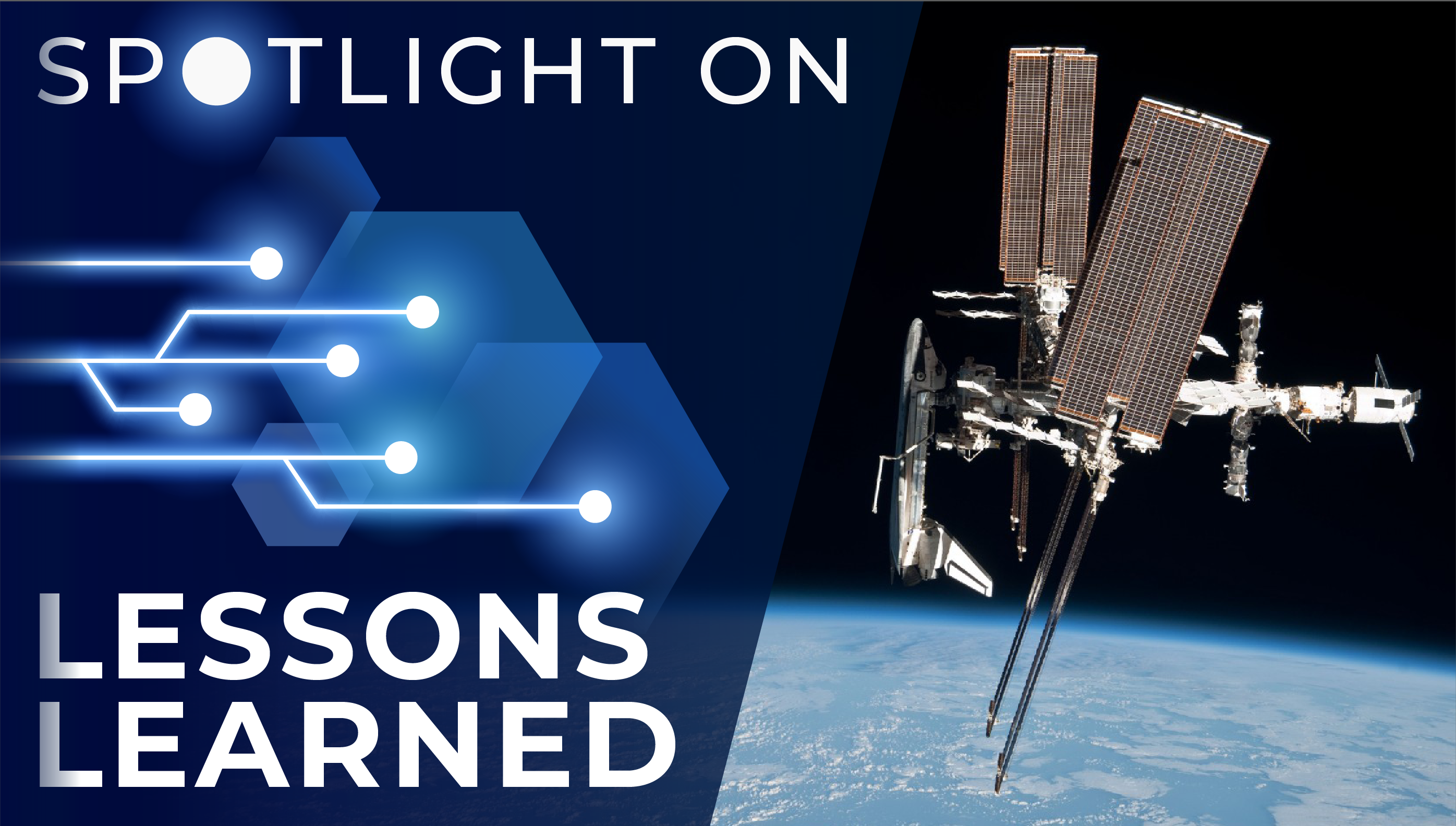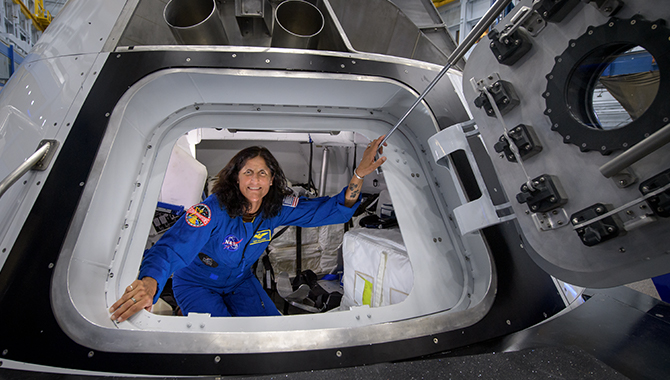
This rendering shows the planned configuration for all six iROSA solar arrays. NASA astronaut Shane Kimbrough and European Space Agency astronaut Thomas Pesquet have installed the first two, the upper and lower iROSAs on the P6 truss, shown here at the far right.
Credit: NASA
New solar arrays, batteries, prepare ISS for key role in Artemis, commercial applications.
In early December 2000, Mission Specialist Marc Garneau, who in 1984 became the first Canadian Astronaut into space and was now a crew member on STS-97, used the Space Shuttle Endeavor’s Remote Manipulator System to lift a large truss from the shuttle’s payload bay. The truss, known as P6, was the first pair of massive solar arrays to arrive at the nascent International Space Station.
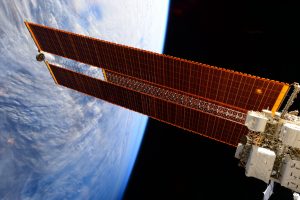
Expedition 43 Flight Engineer Samantha Cristoforetti of the European Space Agency (ESA) photographed the giant solar arrays on the International Space Station on Feb. 12, 2015.
Credit: ESA/NASA
Three more pairs were delivered by space shuttles over the next nine years—in 2006, 2007, and 2009. Together they form a 27,000 sq. ft. installation, arranged in eight wings, each spanning 240 ft. The installations are connected by eight miles of cable, powering the crucial work at the ISS. The arrays had a design life of 15 years, but once in orbit high above the Earth, NASA found that the degradation of the arrays and their 262,400 solar cells was less than expected, with capacity reducing by an average of about 1.5 percent per year.
“Of course, nothing magical happens at the 15-year mark, but the arrays do degrade over time. That’s to be expected,” said Dana Weigel, deputy manager, International Space Station Program, speaking at a NASA press conference in June 2021. “There are a couple of … factors that affect the degradation. One of those is erosion that we see from thruster plumes—both from the station thrusters [and the thrusters of] the crew and cargo vehicles that are coming and going. The other factor that affects our solar arrays is micro meteoroid debris. The arrays are made of a lot of small power strings and over time those power strings can degrade if they are hit by debris.”
As the ISS enters its third decade of scientific research in a microgravity environment, NASA envisions a future in which commercial research and development play a growing, crucial role at the space station. To address solar panel degradation over the past 20 years and to prepare for a future that also includes technology demonstrations for the Artemis program, NASA installed two new solar arrays at the ISS this month, with plans to install four more.
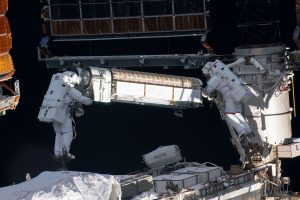
Spacewalkers (from left) Shane Kimbrough and Thomas Pesquet work to install new roll out solar arrays on the International Space Station’s P6 truss.
Credit: NASA
They are known as iROSAs, an acronym for ISS Roll-Out Solar Arrays. The first pair was installed over three spacewalks in late June by NASA astronaut Shane Kimbrough and European Space Agency astronaut Thomas Pesquet. The installations were especially complex because the P6 truss is at the far port side of the ISS, beyond the reach of the Remote Manipulator System, Candarm2. Kimbrough and Pesquet had to take turns repositioning themselves and handing off the 10 ft long iROSA.
The iROSAs arrived at the ISS rolled up and folded at a hinge assembly in the middle, in the trunk of a SpaceX Cargo Dragon. The array’s frame consists of slit tube carbon fiber booms, 6.5 in. in diameter, with an aluminum root structure. After the arrays were installed, two bolts were removed and the stored energy in the carbon fiber booms gently unrolled the panels over about 6 minutes.
When unrolled, each array is 63 ft long by 20 ft wide, significantly smaller than the legacy solar arrays, but equipped with high-energy solar cells that have more than double the beginning of life efficiency—30.7 percent to 14.2 percent. Each will produce more than 20 kilowatts of electricity. When the project is complete, the iROSAs will combine to produce more than 120 kilowatts.
Each of the iROSAs will be canted at a 10-degree angle above the legacy panels, enabling a greater portion of the larger solar arrays to continue to produce electricity. Six iROSA panels and the legacy system will combine to produce about 215 kilowatts of electricity.
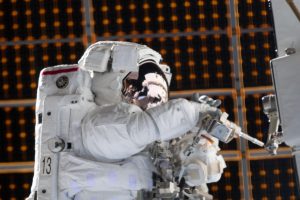
NASA astronaut Jessica Meir is pictured during a spacewalk she conducted with NASA astronaut Christina Koch Jessica Meir (out of frame) to install new lithium-ion batteries that store and distribute power collected from solar arrays on the station’s P6 truss.
Credit: NASA
More than half of the electricity generated by the system when the space station is in sunlight is directed to the ISS’s batteries, to be drawn from when the solar arrays are orbiting through the Earth’s shadow. During a series of spacewalks in 2020, astronauts replaced 48 nickel-hydrogen batteries with 24 new, more efficient lithium-ion batteries, expected to last through 2030.
The upgraded power system will support research into the complex systems that are crucial for NASA to establish a long-term human presence at the Moon and an eventual human mission to Mars. “The microgravity environment is really unique and presents unique challenges, especially for … life support systems that have fluids moving through them. Those behave quite a bit differently in a microgravity environment. So, we are flying and building a lot of exploration-grade life support equipment and it takes quite a bit of power to run that, in addition to running our normal [ISS] life support systems,” Weigel said.
Additionally, NASA awarded a contract in 2020 to Axiom Space of Houston to provide a new module for the ISS that will be used to demonstrate the commercial potential of low-Earth orbit, which has shown great promise in several fields, including regenerative tissue research.
“We signed a contract with Axiom to fly a commercial module up to ISS and that will need a little bit of power. So, there are a lot of things that would benefit from having more power,” Weigel said. NASA is balancing payload demands to determine when the next pair of iROSAs will launch to ISS.
To learn more about the ISS, listen to Episode 46 and Episode 47 of Small Steps, Giant Leaps.






